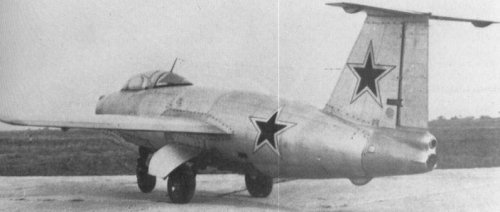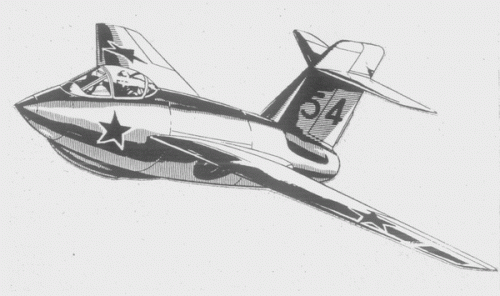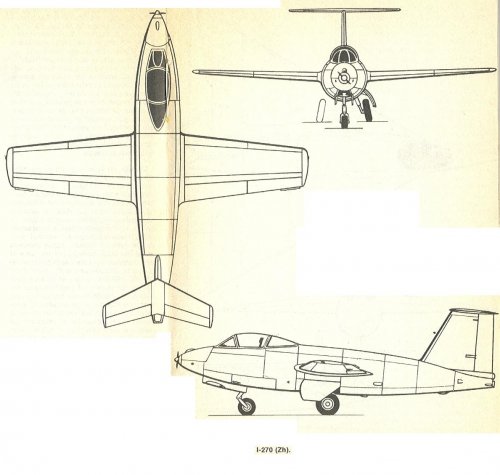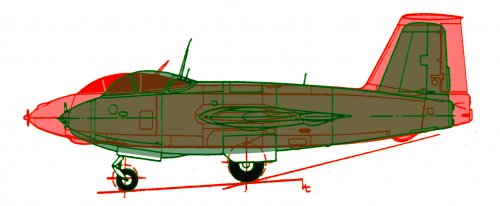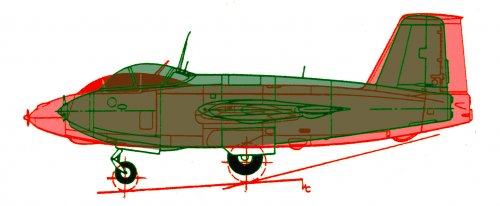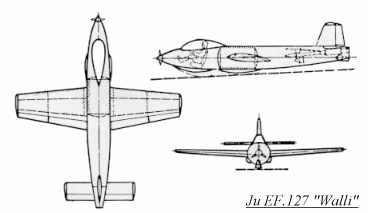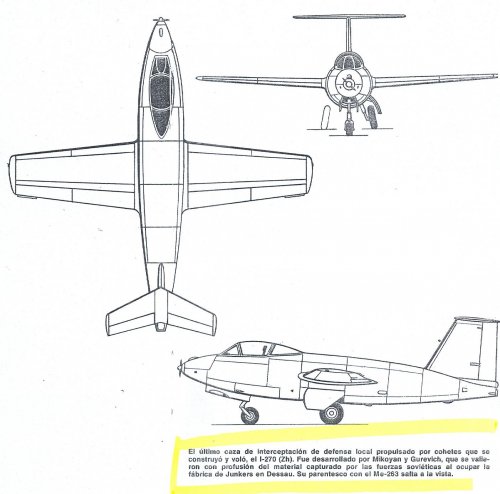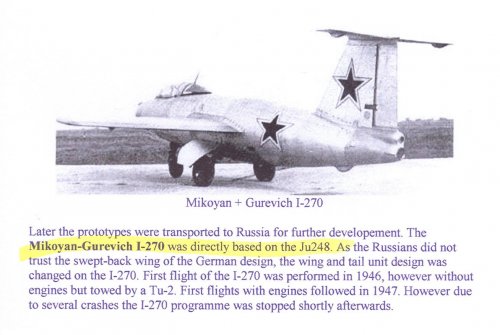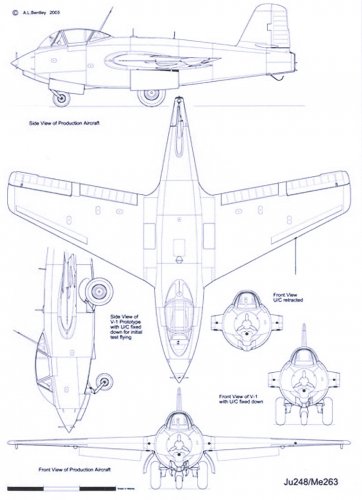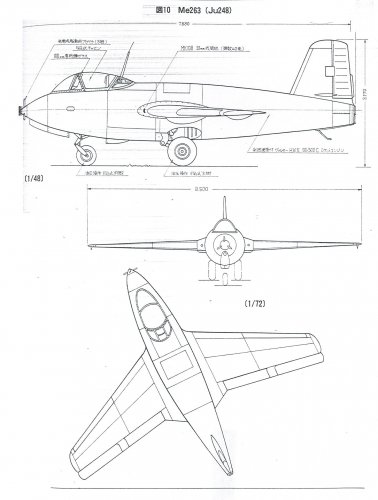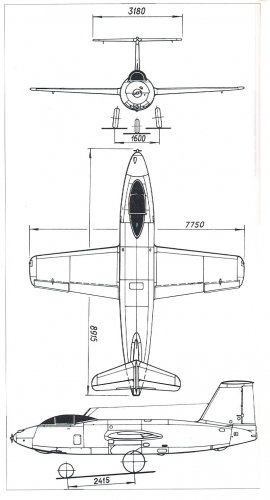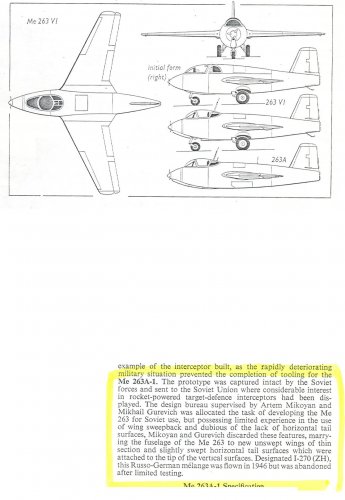You are using an out of date browser. It may not display this or other websites correctly.
You should upgrade or use an alternative browser.
You should upgrade or use an alternative browser.
Mikoyan-Gurevich I-270 jet fighter prototype
- Thread starter dan_inbox
- Start date
- Joined
- 12 July 2006
- Messages
- 916
- Reaction score
- 605
In 'Air Force -the magazine of Air Power' March 1955
the straight winged aircraft is discribed as a rocket powered fighter
and designated Yak-21 !!! (by the author of the article)
Other sources - Le Moniteur de L'Aeronautique :May 1979 speaks about
the aircraft as the Type 11..
"Jak-21" = Mikoyan/Guryevich I-270 = "USAF (Code) Type 11"
In 1947 the USAF decided to give a special type number to all unknown Soviet aircraft (without assignment to any OKB / Type 1 up to Type 40). This procedure ended in 1955 with introduction of the NATO code names. 'USAF Type 11' was Mikoyan I-270 in reality, often, but wrongly described as 'Yak-21' in Western publications.
Regards,
Thomas
Jemiba said:Found in InterAvia 7/1952, a "Jak 21" derived from the Me 163 (obviously !)
Actually it's based on the un-built Me-163 replacement, the Ju-248 (which was supposed to have a longer range).
- Joined
- 25 July 2007
- Messages
- 4,146
- Reaction score
- 3,788
eltf177 said:Actually it's based on the un-built Me-163 replacement, the Ju-248 (which was supposed to have a longer range).
Kind of. The drawing combines the cut-down fuselage of the Me-163C/Ju-248 with the horizontal tail of the Mikoyan-Gurevich I-270 mentioned by boxkite. But, in the drawing, they got the I-170's tail position wrong and kept the swept wing of the Me-163/Ju-248. Quite a chimera ;D
BTW: the Me-263/Ju-248 V1 and V2 were built. They just weren't flown with rocket power.
hole in the ground
ACCESS: Secret
- Joined
- 6 August 2008
- Messages
- 235
- Reaction score
- 23
- Joined
- 11 March 2006
- Messages
- 8,664
- Reaction score
- 3,513
[quote author="redstar72"]But do you really think that I-270 has any connection to 163 family?[/quote]
Well, to support Hesham, this statement can be found (in different gradations) on quite
a number of websites, although some of them at least are using the word "inspired" only,
which could mean a lot or nothing at all. : . The idea of a rocket powered
. The idea of a rocket powered
interceptor dates back to WW I, so I think, that neither Mr. Mikojan, nor Mr. Gurewitsch
really needed inspiration from the Me 163. But there ARE superficial similarities in the shape
of the fuselage, nose section and landing gear ...
Form follows function ?
Well, to support Hesham, this statement can be found (in different gradations) on quite
a number of websites, although some of them at least are using the word "inspired" only,
which could mean a lot or nothing at all. :
interceptor dates back to WW I, so I think, that neither Mr. Mikojan, nor Mr. Gurewitsch
really needed inspiration from the Me 163. But there ARE superficial similarities in the shape
of the fuselage, nose section and landing gear ...
Form follows function ?
- Joined
- 7 June 2009
- Messages
- 528
- Reaction score
- 139
Hi all!
Of course I know…
Very minor similarities, actually. Only in fuselage outlines which are really following function – simply cigar-shaped, without any “architectural extravagances”. Howewer, the 263 and I-270 fuselages are different in length, diameter, and even in shape: Me 263 had curvilinear “aerodynamic” outlines (kind of stretched drop), while I-270 had middle fuselage part cylindrical – like many later MiGs from 15 to 21.
And which is more important – Me 263 and I-270 had totally different aerodynamic configuration. Even if they would have the same fuselage, they would be two different aircraft ! But the real-world ones have very few common features (if any). They both are rocket-powered interceptor fighters with dual-chambered engines – beside this, all the rest was different! For example, Junkers EF-127 Walli project looked much more like I-270 than Me 263 (although it’s notably smaller and has only single-chamber rocket engine). But anybody never proclaimed that I-270 was inspired by EF-127
! But the real-world ones have very few common features (if any). They both are rocket-powered interceptor fighters with dual-chambered engines – beside this, all the rest was different! For example, Junkers EF-127 Walli project looked much more like I-270 than Me 263 (although it’s notably smaller and has only single-chamber rocket engine). But anybody never proclaimed that I-270 was inspired by EF-127  .
.
And:
1. Any reliable Russian source regarding I-270 (including those closely connected with MiG OKB) doesn’t say about any German inspirations;
2. Any reliable source doesn’t confirm that Me 263 or Ju 248 was ever captured by Russians, tested or studied in the USSR. There are neither photos, nor documents – unlike other German jetplanes which were actually tested or studied.
I made more detailed comparative analysis of Me 263 and I-270, their similarities and differences here: http://scalemodels.ru/modules/forum/viewtopic_p_262933.html#262933 (in Russian). Brief English version is here: http://www.secretprojects.co.uk/forum/index.php/topic,9055.msg82592.html#msg82592.
Jemiba said:"But do you really think that I-270 has any connection to 163 family?"
Well, to support Hesham, this statement can be found (in different gradations) on quite a number of websites
Of course I know…
Jemiba said:The idea of a rocket powered interceptor dates back to WW I, so I think, that neither Mr. Mikojan, nor Mr. Gurewitsch really needed inspiration from the Me 163. But there ARE superficial similarities in the shape of the fuselage, nose section and landing gear ...
Form follows function ?
Very minor similarities, actually. Only in fuselage outlines which are really following function – simply cigar-shaped, without any “architectural extravagances”. Howewer, the 263 and I-270 fuselages are different in length, diameter, and even in shape: Me 263 had curvilinear “aerodynamic” outlines (kind of stretched drop), while I-270 had middle fuselage part cylindrical – like many later MiGs from 15 to 21.
And which is more important – Me 263 and I-270 had totally different aerodynamic configuration. Even if they would have the same fuselage, they would be two different aircraft
And:
1. Any reliable Russian source regarding I-270 (including those closely connected with MiG OKB) doesn’t say about any German inspirations;
2. Any reliable source doesn’t confirm that Me 263 or Ju 248 was ever captured by Russians, tested or studied in the USSR. There are neither photos, nor documents – unlike other German jetplanes which were actually tested or studied.
I made more detailed comparative analysis of Me 263 and I-270, their similarities and differences here: http://scalemodels.ru/modules/forum/viewtopic_p_262933.html#262933 (in Russian). Brief English version is here: http://www.secretprojects.co.uk/forum/index.php/topic,9055.msg82592.html#msg82592.
Attachments
As per William Green "Warplanes of the Third Reich" pp 369 and "The Rocket Fighter" pp.153
The I.270 (Zh) was a development from the Me 263/Ju 248
The I.270 (Zh) was a development from the Me 263/Ju 248
Attachments
- Joined
- 7 June 2009
- Messages
- 528
- Reaction score
- 139
OK Justo – now I know WHO bears responsibility for this *** myth! 
With all the respect for Mr. Green – he is definitely mistaken in this case.
I think Mr. Green wrote this many years ago. And, as I see, that time he had very vague conception of how the I-270 appeared and what it actually was. As his text shows, he really imagined I-270 as Me 263 with “alternative” wings ;D ! Is it true? You can make your own conclusion – just look at comparative pictures attached to my previous post!
Also Green shows his very limited knowledge of Soviet aviation history at all. He wrote that our designers were “dubious of the lack of horizontal tail surfaces”. For why? ??? In any way, our experience with tailless aircraft wasn’t less than German (of course you know about Boris Cheranovsky and his works?) At the same time when I-270 was designed and tested, at least two highly advanced projects of swept-wing tailless jet fighters were designed in the USSR – BICh-26 by Cheranovsky and “M” by Oleg Antonov. And the layout of Me 263, with its large, thick wing, definitely wasn’t so advanced. The I-270 layout with small, thin laminar wing is more progressive and more suitable for high speeds. Remember the World’s first aircraft breaking Mach 1 – the legendary Bell X-1: in layout it was a twin brother of I-270!
And, as I already noted, Green’s statement that Ju 248 prototype was captured in Dessau and sent to the USSR to become I-270 is more than doubtful. Anybody never had seen any Ju 248 / Me 263 photos with Red Stars, as well as documents regarding its studying or tests, until now. Dmitry Sobolev, a renowned Russian aviation historian, wrote a book: “German trace in Soviet aviation history”, strongly based on the research he made in archives. In this book there is detailed description: what was captured in Germany, in what quantity, and how all this was used. But any mentions of Ju 248 or Me 263!
is more than doubtful. Anybody never had seen any Ju 248 / Me 263 photos with Red Stars, as well as documents regarding its studying or tests, until now. Dmitry Sobolev, a renowned Russian aviation historian, wrote a book: “German trace in Soviet aviation history”, strongly based on the research he made in archives. In this book there is detailed description: what was captured in Germany, in what quantity, and how all this was used. But any mentions of Ju 248 or Me 263!
Also Mr. Green make mistakes in the story of I-270 itself:
- I-270 wasn’t flown in 1946 – it rolled out from assembly shop only at December 28, and the first flight on tow was made at February 3, 1947 (pilot Viktor Yuganov);
- There were no “several crashes” – only one, at September 2, 1947 (first flight of the 2nd prototype and the first “fire” flight at all), due to pilot's mistake in landing;
- The program was abandoned only in mid-1948 which isn’t “shortly afterwards” (to my mind).
With all the respect for Mr. Green – he is definitely mistaken in this case.
I think Mr. Green wrote this many years ago. And, as I see, that time he had very vague conception of how the I-270 appeared and what it actually was. As his text shows, he really imagined I-270 as Me 263 with “alternative” wings ;D ! Is it true? You can make your own conclusion – just look at comparative pictures attached to my previous post!
Also Green shows his very limited knowledge of Soviet aviation history at all. He wrote that our designers were “dubious of the lack of horizontal tail surfaces”. For why? ??? In any way, our experience with tailless aircraft wasn’t less than German (of course you know about Boris Cheranovsky and his works?) At the same time when I-270 was designed and tested, at least two highly advanced projects of swept-wing tailless jet fighters were designed in the USSR – BICh-26 by Cheranovsky and “M” by Oleg Antonov. And the layout of Me 263, with its large, thick wing, definitely wasn’t so advanced. The I-270 layout with small, thin laminar wing is more progressive and more suitable for high speeds. Remember the World’s first aircraft breaking Mach 1 – the legendary Bell X-1: in layout it was a twin brother of I-270!
And, as I already noted, Green’s statement that Ju 248 prototype was captured in Dessau and sent to the USSR to become I-270
Also Mr. Green make mistakes in the story of I-270 itself:
- I-270 wasn’t flown in 1946 – it rolled out from assembly shop only at December 28, and the first flight on tow was made at February 3, 1947 (pilot Viktor Yuganov);
- There were no “several crashes” – only one, at September 2, 1947 (first flight of the 2nd prototype and the first “fire” flight at all), due to pilot's mistake in landing;
- The program was abandoned only in mid-1948 which isn’t “shortly afterwards” (to my mind).
OK ,you win! 
- Joined
- 27 December 2005
- Messages
- 16,873
- Reaction score
- 21,513
William Green was a respected author of his day but he was writing in the Cold War. Information on Soviet designs at the time was patchy, often wrong, and laced together with lots of guesswork.
I have a copy of this article from 1955. There is a picture of the aircraft flying from the air display and I have tried for years to figure out what it is. It is not ANY of the aircraft you have shown, and I went through all of those possibilities years ago. Wait until Monday. Hopefully the scan will be decent enough...
Although this is the closest I have found. ------------------ The I.270 (Zh) was a development from the Me 263/Ju 248.
The picture is taken from the "Overhead" flight display. The aircraft in the picture has "Natter" like wings and a tail----although larger.
Although this is the closest I have found. ------------------ The I.270 (Zh) was a development from the Me 263/Ju 248.
The picture is taken from the "Overhead" flight display. The aircraft in the picture has "Natter" like wings and a tail----although larger.
- Joined
- 31 July 2013
- Messages
- 556
- Reaction score
- 1,134
Can I add my two happorth as it were. Having the privilege of having worked with William Green, or Bill as I got to know him, I back everything that the boss, Overscan placed above. When Aerospace Publishing, my old employers, were looking at the revamp of Warplanes of the Third Reich, we had quite in depth conversations with Bill, in regards to changes such as the erroneous info regarding the Me 263/Ju 248, as well as the classic Ju 390 to the US coastline story amongst many others. He fully admitted that his information was only based on what was known. Despite this, I regarded the man as a genius and was so proud that I had the chance to work with the man before he was taken from us.
nuuumannn
Cannae be ar*ed changing my personal text
- Joined
- 21 October 2011
- Messages
- 276
- Reaction score
- 537
Despite this, I regarded the man as a genius and was so proud that I had the chance to work with the man before he was taken from us.
Well spoken, sir.
Similar threads
-
Mikoyan-Gurevich MiG-8 "Utka" (Duck)
- Started by Stargazer
- Replies: 18
-
New Fonthill Book - Rocket Interceptors 1941-1947
- Started by Justo Miranda
- Replies: 2
-
Florov-Isayev "Aircraft 4302" rocket-propelled prototype
- Started by dan_inbox
- Replies: 10
-
-

